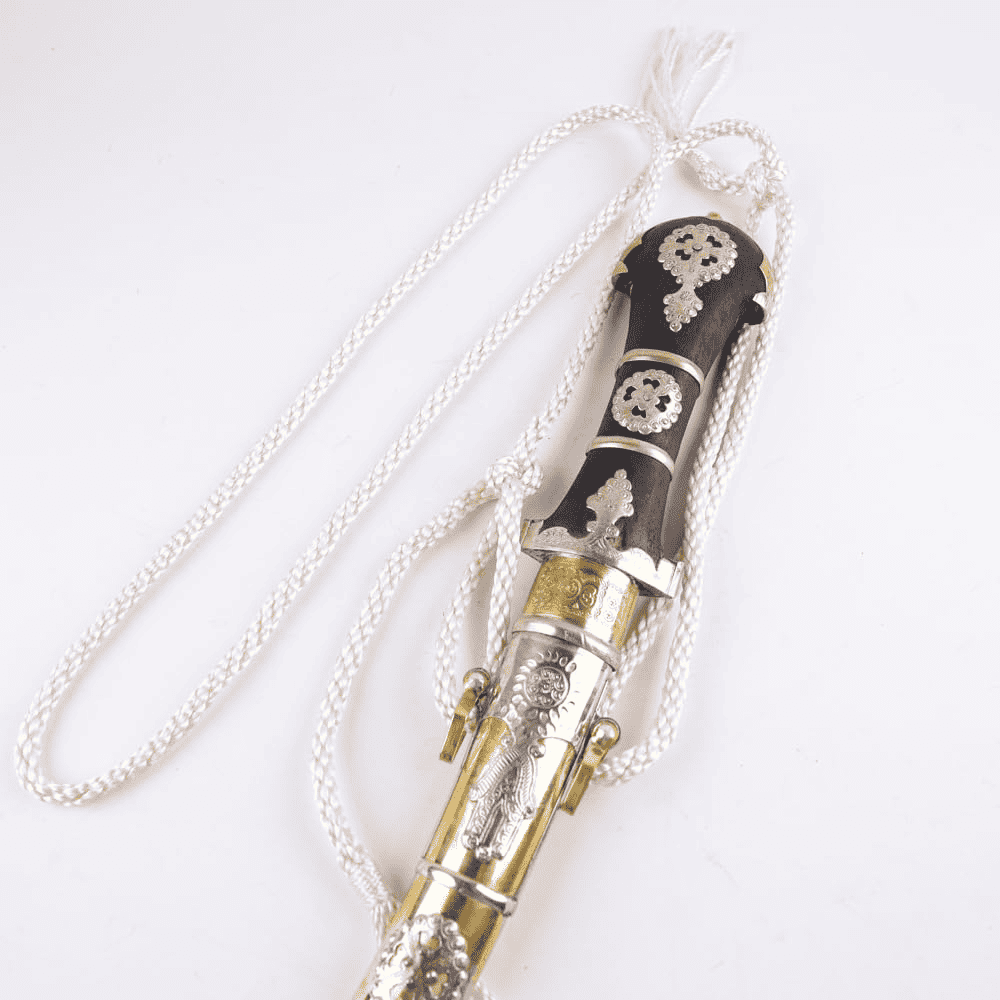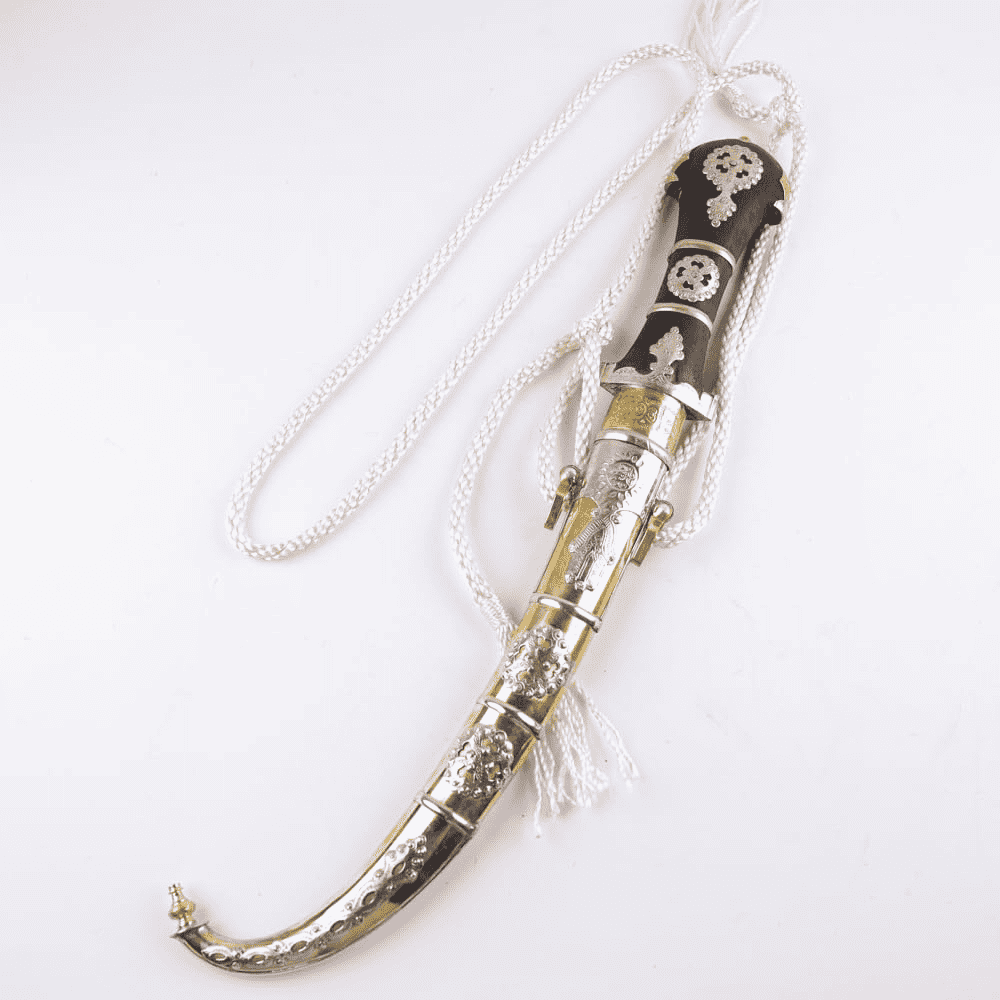What Is the Moroccan Koummya and Why Is It Considered Unique?
The Moroccan Koummya, also spelled Koumaya, is a traditional Berber dagger known for its curved blade and distinct craftsmanship. This version reflects cultural heritage rooted in centuries of North African history, particularly among the Chleuh Berbers of the Atlas Mountains. While classified as a weapon, it functions more as a symbol of pride, group identity, and status. The dagger is typically worn during festivals or formal attire, sheathed at the waist and fastened with a shoulder cord, showcasing the scabbard’s forward-leaning tip.
Its distinguishing curve, unlike straight blades, speaks of Arabic Jambiya ancestry. This shape, inherited through centuries, lends the Koummya a ceremonial presence rather than a utilitarian one.
Key points:
- Symbol of cultural identity among Berber tribes
- Descended from the Arabic Jambiya family
- Traditionally worn on djellabas during ceremonies
- Curved blade design makes it visually distinctive
How Does the Blade’s Material Impact Durability and Visual Appeal?
This medium-sized Koummya dagger features a stainless steel blade, known for its corrosion resistance and long-term strength. Although minor rust marks might be present, they add to its aged appearance, emphasizing the handcrafted nature of the item. Unlike factory-made blades, the slight irregularities in this dagger give it character and authenticity. While it’s not intended for use in combat, the blade holds a sword-like finish, making it suitable for collectors, reenactors, and enthusiasts who value traditional weapon designs.
The spine thickness, measured at 1.20 inches, adds weight and balance, ensuring the knife feels substantial in hand. It’s decorative, yet functional in shape and construction.
Key points:
- Stainless steel blade with visible handcrafted qualities
- Spine thickness of 1.20 inches offers realistic feel
- Slight rust or imperfections enhance authenticity
- Ideal for display, collection, or costume purposes
What Is the Function of the Wooden Hilt and How Does It Complement the Blade?
The hilt of the Koummya is carved from wood and shaped to fit comfortably in hand. With a 5.32-inch handle (medium size), it is proportionate to the blade and provides a balanced grip. The handle is minimal in design but functional in purpose, reinforcing the handmade nature of the dagger. It complements the blade with a traditional profile, creating a smooth transition from hilt to spine.
Because the wood is untreated and unvarnished in many versions, its natural grain remains visible. This reinforces the handcrafted appeal of the dagger and supports its cultural presentation.
Key points:
- Wooden hilt designed for balance and grip
- Handle size proportional to blade for proper alignment
- Organic finish with visible wood texture
- Matches traditional Moroccan style and usage
What Are the Measurements and Why Do They Matter?
The medium-size dagger measures 16.53 inches in total, combining practicality with presence. The blade extends 8.90 inches, while the hilt adds 5.32 inches. The scabbard itself measures 10.24 inches, forming a protective and decorative sheath that blends seamlessly into the overall look. Each measurement contributes to the dagger’s usability, wearability, and overall impression.
For decorative collectors, accurate sizing is crucial to determine if the item fits within a display case, wall rack, or wearable costume. The proportions also replicate historical accuracy, closely aligning with traditional Moroccan standards.
Key points:
- Total length: 16.53 inches for medium model
- Blade: 8.90 inches; Hilt: 5.32 inches
- Blade thickness ensures realistic weight
- Scabbard size aligns with historical ceremonial versions
What Role Does the Scabbard Play in Function and Design?
The handmade scabbard is an essential feature of the Koummya. Crafted to fit the blade’s curvature exactly, it serves both as protection and aesthetic. In traditional settings, the scabbard is worn tilted forward on the left side and fastened to the right shoulder. This unique placement, held by two suspension rings, reinforces the dagger’s ceremonial function.
Scabbards are often detailed with patterns or metalwork in larger versions, but even simple designs like this reflect traditional expectations. It enhances the overall structure, allowing the dagger to retain its historical presence when displayed.
Key points:
- Scabbard constructed for curved blade fit
- Supports cultural carry-style with ring suspension
- Adds length and balance to the dagger
- Traditional display and wear accuracy
How Does This Item Reflect Traditional Moroccan Berber Craftsmanship?
Every detail of this Koummya points to traditional Moroccan handwork. Made by local artisans rather than manufactured, imperfections are expected—and welcomed. These small variations between pieces underline the individuality of each dagger. From asymmetry in the blade grind to slight inconsistencies in the wood grain, the piece resists modern uniformity.
The crafting techniques have been passed down generationally, especially among tribes in the High Atlas region. This item supports artisan continuity and cultural preservation.
Key points:
- Fully handmade with artisan-specific differences
- Inconsistent details affirm authenticity
- Culturally preserved techniques and styles
- Symbol of Moroccan craftsmanship legacy
What Are the Historical and Cultural Roots of the Koummya?
The Koummya’s origins trace back to the broader Jambiya dagger tradition, widespread throughout the Arabian Peninsula. The Moroccan version evolved among Berber communities, where it became more than a weapon. It now represents regional identity, social position, and tribal affiliation.
Unlike standard Jambiyas, the Koummya’s scabbard and hilt design reflect Moroccan influences—more curved and stylized. Wearing it at weddings, parades, or religious ceremonies is common, reinforcing its standing in local culture.
Key points:
- Evolved from Jambiya family of Arabian daggers
- Holds non-combat social and ceremonial role
- Cultural integration among Berber tribes
- Symbol of heritage, masculinity, and tradition
Why Is This Item Suitable for Collectors and Decorative Use?
Due to its handcrafted construction and culturally rooted design, this Koummya is ideal for collectors of Islamic artifacts, Middle Eastern weaponry, or North African antiques. It’s also suitable as a conversation piece in homes, offices, or themed displays. While functional in shape, it’s not intended for cutting or utility work.
Collectors will find the imperfections to be marks of character, not flaws. These include slight discoloration, minor rust spots, or irregular blade edges—indicators of hand-forging rather than machining.
Key points:
- Collector-grade quality with artisanal appeal
- Not intended for practical use or cutting
- Ideal for display or collection of Islamic relics
- Unique and region-specific item
How Should This Dagger Be Displayed and Maintained?
The Koummya can be displayed on a wall mount, inside a glass case, or laid flat on a textile mat. Keep it in a dry environment to limit rust exposure. Occasional oiling of the blade can help preserve its condition. Do not polish aggressively, as this can remove signs of handwork.
Due to the handmade wood and steel components, avoid exposing it to water, direct sunlight, or harsh chemicals. Display it upright or angled, ensuring the curve is visible to emphasize the silhouette.
Key points:
- Best displayed on wall or in a glass case
- Store in dry areas to avoid rust
- Light oiling maintains blade finish
- Avoid moisture and chemical exposure
What Size Options Are Available and How to Choose?
This Koummya is offered in both medium and large sizes. The medium version measures 16.53 inches in total, with an 8.90-inch blade. The large version, although similarly long overall (16.52 inches), features a slightly longer hilt (6.30 inches) and slightly shorter blade (8.70 inches). Both options provide nearly identical visual weight, but the large version sits heavier in the hand due to its extended grip.
Choose the size based on intended display space, weight preference, and desired grip style. For traditional belt wear or costume use, either version is viable.
Key points:
- Two size variants: Medium and Large
- Medium: 5.32″ hilt, 8.90″ blade
- Large: 6.30″ hilt, 8.70″ blade
- Both fit traditional Moroccan wear or display





Reviews
There are no reviews yet.